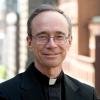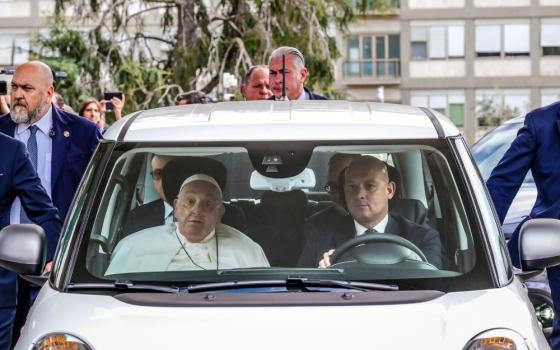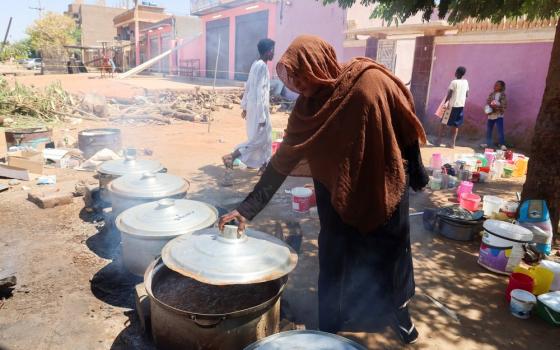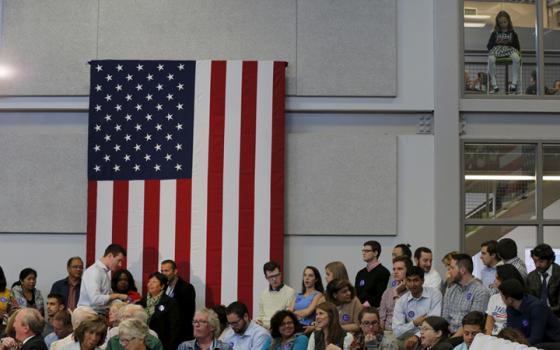The sexual abuse crisis was the worst crisis to have hit the U.S. Catholic church in the 20th century. It destroyed the lives of thousands of children, cost the church billions of dollars, and undermined the authority of bishops in the church. While many would like to move on from the crisis, others fear that if we are not vigilant, more abuse will happen.
One way of knowing the current state of the abuse crisis is through the annual report done for the U.S. bishops' conference on the implementation of the Charter for the Protection of Children and Young People, colloquially known as the Dallas charter.
This year's report, the 11th so far, is divided into two parts: the finding of a three-year audit done by StoneBridge Business Partners and a statistical report on new allegations of abuse in 2013 conducted by CARA, the Center for Applied Research in the Apostolate.
The latest audit shows continued improvement but still indicates that some areas need improvement, as explained by Joshua J. McElwee's excellent article.
One diocese (Lincoln, Neb.) and three eparchies refused to participate. The National Review Board also urged more bishops to allow parish audits and not just on-site audits of dioceses. In 2013, StoneBridge visited 91 parishes and schools in 26 dioceses, a 44 percent increase over the year before.
Dioceses were also urged to improve the accuracy of their databases documenting the number of clergy and volunteers undergoing background checks and training. The extent and quality of these programs vary from diocese to diocese, but it is hard to document because of difficulties of collecting data.
Some dioceses "continue to struggle with outdated information, lack of cooperation at the parish/school level, and inefficient processes for information gathering." As a result, the auditors were "furnished incomplete or inaccurate data which affects the reliability of the information presented" in their report. The auditors said changes in personnel could also lead to a breakdown in the process.
The USCCB Secretariat of Child and Youth Protection found "diocesan concerns around the issues of boundary violations, letters of suitability, and how often diocesan/eparchial review boards should meet." Between 2011 and 2013, seven dioceses/eparchies were found to be noncompliant because the bishop had not convened their review boards. Even though these dioceses had no allegations during the period, the auditors reminded the bishops that the boards were required to meet to review diocesan policies and procedures. They have promised to comply.
Despite these problems, dioceses were found to be compliant with the charter's mandatory reporting process and procedures. The audit also reported diocesan actions that went above and beyond the requirements of the charter.
Critics object that the audit is based on self-reporting by dioceses and review of written policies, not actual practice. The auditors acknowledge that the compliance letter only states whether a diocese is "in compliance with the data collection requirements for the 2012/2013 Charter." It "does not imply that a diocese or eparchy is compliant with the Charter. Compliance with the Charter can only be effectively determined by participation in an on-site audit." During the three-year period, StoneBridge auditors visited 188 of the 195 dioceses and eparchies.
In the on-site audits, compliance with the mandatory reporting requirement "was determined by review of related policies and procedures, letters to local authorities regarding new allegations, and interviews with diocesan/eparchial personnel responsible for making the reports," according to the auditors. "In some instances, auditors reached out to the applicable public authorities and confirmed diocesan cooperation." But the auditors interviewed only two victims and two accused clerics in 2013.
Although the church sometimes is prevented from reaching out to victims because of litigation, "dioceses and eparchies provided outreach and support to 340 new survivors and their family members during the audit period. Continued support was given to 1,843 past survivors and family members."
Besides determining compliance with the charter, the auditors also gave "management letters" to many dioceses with their recommendations for improving. The information in the report on the content of these letters gives a good indication of the concerns auditors raised.
For example, they recommended that dioceses clearly define what "prompt" reporting of allegations means and how soon an accuser could expect a response from the diocese. And although diocesan websites published their policies and procedures, some websites in the audited parishes did not. Twenty of the management letters addressed these problems.
Twelve bishops were told to update their diocesan policies to include adults who "habitually lacks the use of reason," as required by church law. Thirty were reminded to update their policies to include child pornography under child abuse. Four dioceses did not have a written document describing their process for removing accused clerics, although they did have a process. They were told to document the process.
Two bishops in violation of the charter were found to have failed to announce to the affected parishes the removal of an accused priest. Both bishops immediately made the appropriate announcements.
Five dioceses and eparchies were told to develop policies regarding virtual interaction with children by personnel, including teachers, catechists and coaches.
The auditors also recommend that dioceses and eparchies ensure that background screening agencies used for charter compliance include records from all appropriate jurisdictions, including sex offender registries.
While it is disappointing that dioceses had to be told to do these things, it is comforting to know that the auditors are catching failures and telling bishops to fix them. The auditors concluded: "The Catholic Church in the United States continues to handle the issue of sexual abuse of minors by clergy effectively through the implementation of the Charter for the Protection of Children and Young People."
Looking at the statistics
StoneBridge reports that of the 936 allegations against clerics in the 2011 to 2013 period, 472 allegations were deemed by the audit "unable to be proven." That is just over half the allegations. That is a lot of allegations. What is going on here?
According to the report, an allegation is unable to be proven when there is not enough evidence to determine whether or not abuse occurred. In the report, "unable to be proven" allegations are distinguished from 78 "unsubstantiated" allegations and 223 allegations where an investigation is still ongoing.
As a result, an "unable to be proven" allegation is a closed case where there was not enough evidence to determine whether or not the abuse occurred. To have 472 such allegations in this three-year period is at first glance quite disturbing. Does this uncertainty mean that children are not safe? What happens to priests with "unable to be proven" allegations?
But reading further, we discover, "This is generally the outcome of an investigation when the accused cleric is deceased." Since the report tells us that 204 of the 730 accused priests are dead, that means a lot of these "unable to prove" allegations are against deceased clerics. I would guess that fewer resources are devoted to investigating these allegations because the accused can no longer endanger children.
There are also allegations against 217 unknown clerics (men the victims could not or would not identify), which would make it difficult to investigate. Bankruptcy proceedings have further complicated the process. For example, in 2013, "the Diocese of Spokane received 118 allegations from 88 victims via its bankruptcy proceeding. The diocese is unaware of the identities of the victims or the accused, and is unable to determine whether the allegations have been reported before." These allegations were included in the 936 listed by the audit.
In addition, 44 of the accused had been laicized, 131 removed from ministry, and 13 resigned.
Only 50 accused clerics are still in active ministry. StoneBridge does not give information on these men, but they appear to be priests still in ministry pending a preliminary investigation into the allegations or clergy returned to ministry following a resolution of their cases.
Looking only at the most recent year for dioceses and eparchies, CARA found: "Three-quarters of alleged offenders (73 percent) identified in 2013 are deceased, already removed from ministry, already laicized, or missing."
Only nine diocesan clerics who were accused in 2013 were returned to ministry; nine more were returned to ministry who were accused before 2013. Ten accused clerics were still active pending an investigation, including three identified prior to 2013.
CARA goes on to note, "Another 19 priests or deacons (7 percent) were permanently removed from ministry in 2013." Twenty-three clerics who had been accused before 2013 were also permanently removed from ministry in 2013.
In addition, 84 clerics (28 who were identified in 2013 and 56 who were identified before 2013) have been temporarily removed from ministry pending completion of an investigation.
There is no data on the total number of clerics who have been temporarily removed from ministry or how long they have been on suspension. I have always considered this a serious lacuna in the data collection process. Investigations that go on indefinitely are fair neither to the priest nor the victim. Justice delayed is justice denied. How can we know how well the system is working without this information?
Of the 290 diocesan priests and deacons identified as alleged offenders in 2013, 56 percent had already been identified in prior allegations. Since 2006, the percent of new alleged offenders has ranged between 36 and 45 percent of the accused.
This statistic is disturbing. That 128 newly accused clerics appeared last year (and similar or higher numbers have appeared each year since 2006) shows that there are likely to be many more unknown offenders, either alive or dead. It is the live ones who are still at large that are of greatest concern. This is why it is so important for dioceses to encourage victims to come forward.
The good news is that the number of allegations has declined markedly since 2004. In 2013, 365 victims made 370 allegations against 290 diocesan priests or deacons. In 2004, the respective numbers were 889, 898 and 622.
Of the 370 new allegations, only nine, or 2 percent, involved children who were still minors in 2013. Two-thirds of new allegations (69 percent) occurred or began between 1960 and 1984. The most common time period for allegations reported in 2013 was 1970 to 1979 (125 allegations). "This is approximately the same time pattern that has been reported in previous years," reports CARA, "with most allegations reportedly occurring or beginning between the mid-1960s and the mid-1980s."
The lack of many new allegations for the 1990s provides evidence that the church was finally getting its act together at that time.
In addition, of the 370 new credible allegations reported in 2013, 63 new allegations (17 percent) were unsubstantiated or determined to be false by Dec. 31. An additional 33 allegations received prior to 2013 were unsubstantiated or determined to be false during 2013. From 2006 to 2013, the percent of unsubstantiated or proven false accusations has ranged from 7 to 17 percent.
Eighty percent of the victims were male, nearly identical to previous years. Forty-four percent of the victims were between the ages of 10 and 14, with 22 percent between 15 and 17, and 12 percent under the age of 10.
All but one diocese (Lincoln) participated in the 2013 CARA survey, but only 155 of the 215 clerical orders of men participated, about the same response rate as in earlier years.
CARA examined information on religious orders in a separate chapter. Ninety-two victims made 94 allegations against 62 offenders (down from 194, 194 and 134 respectively for 2006). Three-quarters of the accused religious priests were deceased, already removed from ministry, or already left the religious institute at the time of the allegation in 2013. Another 8 percent were permanently removed from ministry in 2013. Only four priests were returned to ministry in 2013, and one priest was in active ministry pending an investigation. Of the 94 new allegations, 10 were determined to be unsubstantiated.
The annual report is not fun reading both because of the topic and the detailed reporting. Every allegation of sexual abuse is bad news, but the fact that the allegations are public and that the numbers are declining is a bit of a silver lining.
[Jesuit Fr. Thomas Reese is a senior analyst for NCR and author of Inside the Vatican: The Politics and Organization of the Catholic Church. His email address is treesesj@ncronline.org. Follow him on Twitter: @ThomasReeseSJ.]
Editor's note: We can send you an email alert every time Thomas Reese's column, Faith and Justice, is posted. Go to this page and follow directions: Email alert sign-up.




